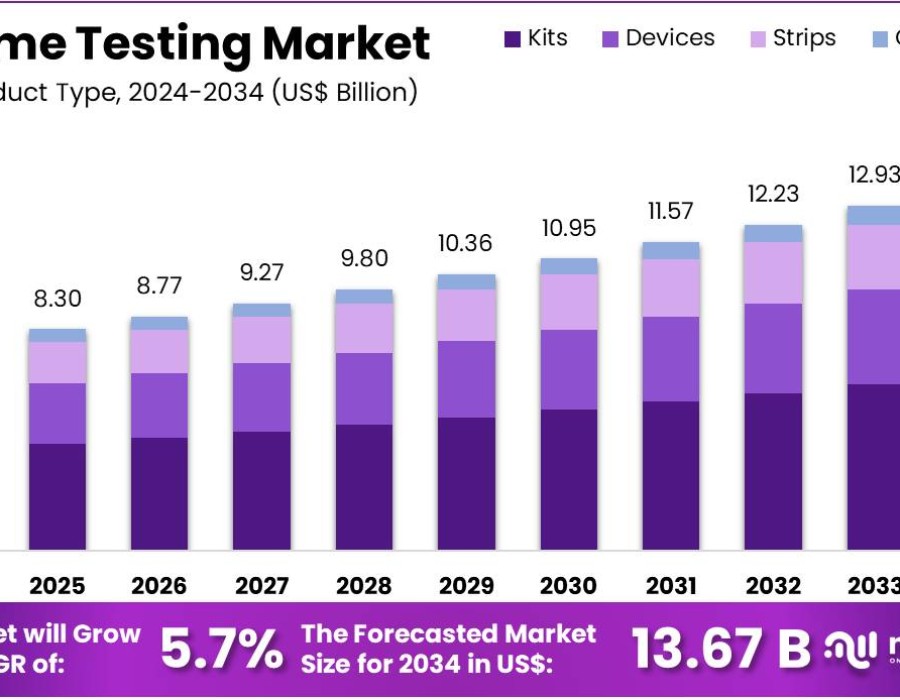The Global At-Home Testing Market is steadily expanding, projected to grow from US$ 7.85 billion in 2024 to US$ 13.67 billion by 2034, at a CAGR of 5.7%. This rise is driven by a growing preference for home-based care and increasing trust in the accuracy of self-testing kits. Repeat purchases of items like strips and swabs offer predictable revenue, attracting investors and intensifying competition. Public health support plays a key role, with WHO and national agencies endorsing self-testing for conditions like HIV and hepatitis. These policies improve access, especially in underserved areas. The COVID-19 pandemic also accelerated adoption, familiarizing millions with at-home diagnostics. Regulatory bodies now fast-track approvals, expanding test options for consumers. Looking ahead, growth is shifting toward chronic disease monitoring, cancer screening, and app-connected devices, enabling remote care and real-time public health tracking. As a result, both consumer adoption and industry investment remain strong.
![]()
Key Takeaways
- In 2024, the global at-home testing market hit US$ 8.5 billion, projected to grow to US$ 13.67 billion by 2034 at 5.7% CAGR.
- Kits dominated the product type category in 2024, accounting for 48.25% of the total market due to their user-friendly design and wide availability.
- Among sample types, blood-based tests led the market in 2024 with a 36.5% share, reflecting growing use in chronic disease detection.
- Chronic disease monitoring emerged as the leading application segment, capturing 38.9% of the market thanks to rising lifestyle-related health conditions globally.
- Offline sales channels outpaced online in 2024, securing 63.4% of the distribution share due to consumer trust and easier accessibility.
- North America took the lead in regional share, holding 39.5% of the global at-home testing market in 2023, driven by advanced healthcare infrastructure.
Opportunities
- Strong Support from Health Organizations: Global health authorities are now supporting the use of self-tests for a growing number of conditions. This opens the door for more types of tests to be used at home, beyond just viral infections.
- Growth of Telehealth: At-home testing works well when combined with telemedicine services. Users can share results with doctors online and get help without visiting a clinic. This makes healthcare more accessible and reduces system burdens.
- Growing Interest in Health Monitoring: People want more control over their health. Many are using self-tests to monitor chronic conditions like diabetes or heart health. This creates long-term demand for easy-to-use kits that offer quick feedback.
- Faster Regulatory Approvals: Some countries are offering fast-track approval systems for new at-home test kits, especially when they are linked to public health needs. This helps innovative products reach the market faster.
- Digital Tools and Apps Create Better Experiences: Many companies are adding mobile apps and AI features to their test kits. These tools help users understand their results better and make the testing process smoother and more reliable.
Conclusion
The at-home testing market is growing steadily as people seek faster and easier ways to manage their health. The shift toward self-care, supported by digital tools and public health policies, is making testing more common and trusted. Despite a few challenges like sample errors and data privacy concerns, strong support from governments and health organizations keeps the momentum going. Companies are also investing in smart apps and user-friendly kits, helping more people monitor chronic conditions from home. As telehealth grows, at-home testing becomes a key part of modern healthcare. With continuous innovation and better access, this trend is set to shape the future of patient-centered care.





Comments